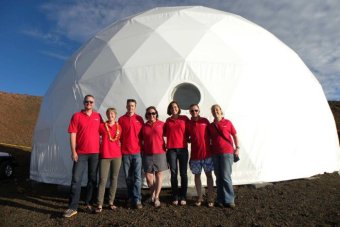.

The geodesic dome on Mauna Loa volcano in Hawaii.
.
Six aspiring astronauts have spent the last seven months living in a geodesic dome on Mauna Loa volcano in Hawaii to simulate a spaceflight mission to Mars.
The stark, rocky slopes of Mauna Loa are about 225 million kilometres away from Mars, but for NASA researchers wanting to find out how humans might survive in a Martian environment, it is the closest thing they have to the red planet.
The project is called HI-SEAS — Hawaii Space Exploration Analog and Simulation.
It feels like living in an apartment with your friends all the time and you just never go outside for some reason.
Mission commander Dr Martha Lenio
Mission commander Dr Martha Lenio, a University of New South Wales graduate, is living inside the dome with her crew mates, and made a recording of her experiences for the ABC.
"You look out the window and there's no green, there's no trees, there's no little plants growing around," she said.
Audio: Listen to Liz Hobday's report. (AM)
"There's no habitation really ... it's just rocks. So it does look like Mars when you look out the window."
This is the third HI-SEAS mission — the current crew entered the dome last October.
"The main point of the HI-SEAS study is to figure out how to pick a crew that works well together, that's able to stay positive, happy, productive, and cohesive through a long duration isolated mission," Dr Lenio said.
NASA hopes to send humans on a mission to Mars in the 2030s, but the red planet is so far away the trip could take three years — and communication with Earth would be limited.
"You are going to have to be autonomous, you're going to have to figure things out for yourself," Dr Lenio said.
Cut off from the outside world
The crew is confined to a two-storey dome on the volcano's isolated northern slopes.
The dome looks just like an oversized golf ball, and measures just 11 metres across.
It has just one tiny porthole window, because on Mars humans would need constant protection from solar radiation.
There is a laboratory, a bathroom, an exercise area, and tiny bedrooms upstairs.
"We want it to be as Mars-like as possible," Dr Lenio said.
"But for me it feels like living in an apartment with your friends all the time and and you just never go outside for some reason."
When they do venture onto the volcanic slopes outside the dome, the HI-SEAS crew must simulate a spacewalk by putting on a space suit and entering a pressurisation chamber.
.

Photo: HI-SEAS III crew just prior to entering the dome. L-R: Neil Scheibelhut, Sophie Milam, Zak Wilson, Kim Binsted (not staying inside dome), Jocelyn Dunn, Allen Mirkadyrov, Martha Lenio. (HI-SEAS: Facebook)
.
Inside the dome, there is limited communication with the outside world.
Emails and internet use are delayed by 20 minutes because of the time it would take a radio signal to travel from Earth to Mars at the speed of light.
Electricity use is also restricted as the crew relies mostly on solar energy.
A few cloudy days could mean no computer use as the crew conserve energy for their work for NASA and to keep the dome running.
"We have a lab freezer, a deep freeze with human saliva, urine, and hair for the NASA studies," Dr Lenio said.
"We have composting toilets with fans and heaters on them and that is our major baseload, really, and if those go down the whole place will stink up," she said.
For the most part the mission has been a success, but as they enter the final weeks of life inside the dome, some of the researchers have encountered problems.
"We've had a few rather difficult bouts of depression from a couple of crew members," Dr Lenio said.
"I guess just being supportive and working through that required a few team conversations."
The researchers will emerge from the dome in three weeks, simulating re-entry to the Earth's atmosphere with a skydive.
Crew grow food to fight 'menu fatigue'
A surprising problem for humans on extended space flight missions is what is on the menu.
Relying on freeze-dried and other pre-packaged food for long periods leads to a phenomenon called "menu fatigue", where food starts to taste the same.
This can lead to a loss of appetite, weight loss and depression, so the HI-SEAS project is looking at what a space crew might eat.
The crew members cook every few days, with a head chef, a sous chef and a couple of people on washing up duty.
The team has dined on gumbo, sushi, and Mexican food, and there is even an appetite for dessert on simulated Mars.
The HI-SEAS crew has been able to grow some food under artificial light.
Dr Lenio has been working on growing plants including basil, coriander, and lettuce.
"They already do experiments on the international space station growing tomatoes and things in space," she said.
"My work here is focused on growing as many plants and as many different varieties of plants as possible indoors with LED lighting."
The crew is also taking care of a pet fish named Blastoff McRocketboots.
.
Quelle: Radio Australia
4421 Views
